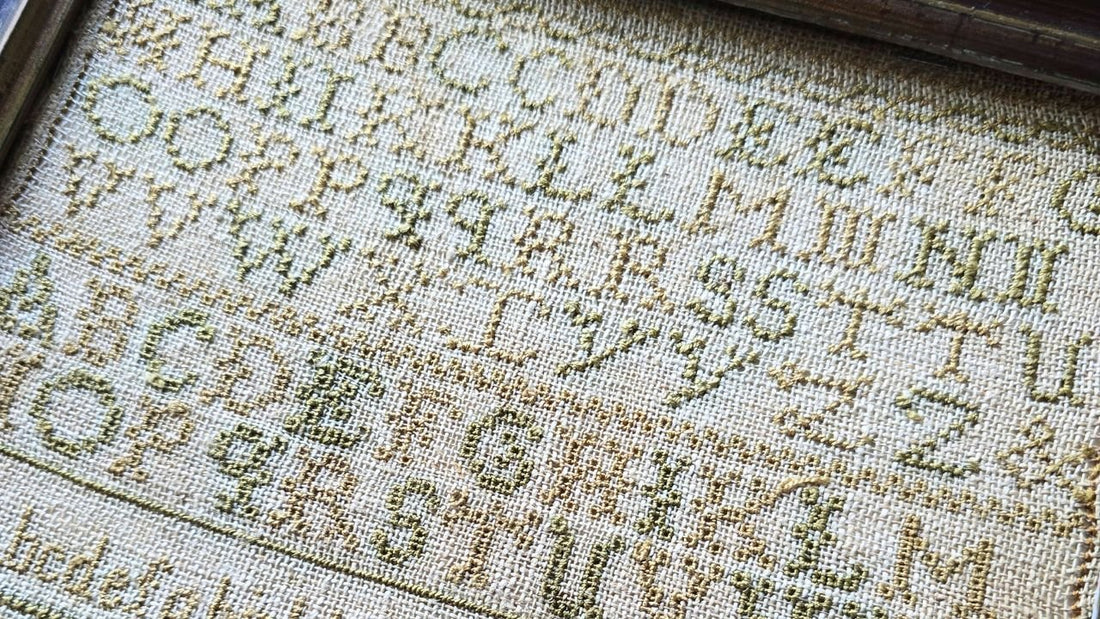
Missing Letters in Early Samplers: The Evolving Alphabet in Stitch
When browsing antique or reproduction samplers, you may notice something curious: some letters of the alphabet are missing. The most commonly omitted characters are J, U, W, sometimes V, and occasionally even Q, X, Y, or Z. Why? The answer lies in the evolution of alphabets, schooling practices, and aesthetic or practical constraints in sampler design.
Historical Roots: The Latin Alphabet Then and Now
To understand why letters go missing, we need a brief detour through alphabet history:
Classical Latin, as used by the Romans, did not distinguish between I and J, or between U and V. In inscriptions, I could function as both vowel and consonant, and V covered the “u” sound.
Over time (late medieval to Renaissance periods), the letters J and U gradually emerged as distinct in many European languages. But this transition was uneven and gradual.
Thus, earlier forms of the Latin alphabet, and many educational practices, continued to treat I/J and U/V as variants of a single letter for much of the early modern period.
Because of this legacy, many early samplers omit J and U, using I (or V) in their stead. The National Museum of American History notes that many early American samplers leave out “J” and “U” because they simply were not part of the Latin alphabet then, and the letter “I” stood in for “J,” while “V” worked for “U.”

(A.L. F.L 1861 missing "J" and the "W" - a great example of a 24 letter alphabet)
Thus, when a young needleworker in the 18th or early 19th century stitched her ABCs, she might simply omit J and U because she learned them that way, or because her schooling materials and local conventions didn’t require them.
Substitutions, Aesthetics & Practical Constraints
Beyond the historical absence of letters, several practical and aesthetic reasons contributed to omissions or substitutions in sampler alphabets.
Substitution by Similar Letters
I / J: When J was omitted, I often took its place. A name like Julia might be stitched as Iulia.
U / V: Likewise, V often stood in for U, and some samplers don’t include U formally at all.
In some designs, W is left out (or subsumed under V) because W can conceptually be thought of as a double-V; including it could be seen as redundant or too space-consuming. (See image above)

(Frances Cole 1782 omitted the "J" in all her alphabets)
Spacing & Layout
In early samplers, space was at a premium. If a stitcher or teacher wanted to fit the entire alphabet into a neat rectangle or align with borders, omitting a few letters simplified layout challenges.
Some samplers drop the final letters (X, Y, Z) not because of ignorance but purely to make the last row more even or to avoid crowding at the margins.

Pedagogical or Design Traditions
Sometimes missing letters represent tradition — samplers were often copied from older examples or pattern books, and omissions got mechanically carried forward.
In some religious or artistic contexts, an intentional “mistake” or omission might be included (so that the work is not “perfect”) — an expression of humility, that only the divine can achieve flawlessness. Some modern stitchers and sampler designers echo this tradition by deliberately omitting a letter as a subtle nod to that history.
Mistakes (oversights) also happen, early student sampler makers might simply have skipped a letter without realizing it, especially if their attention or materials were limited.

Regional & Linguistic Variation
German, Dutch, and other European tradition-influenced samplers sometimes reflect alphabets that historically did not include J, V, or W in their standard alphabets. The Dutch and German samplers sometimes reflect an early Latin alphabet that did not include J, V or W.” Thus, a sampler stitched in a German-speaking or Dutch-influenced community might omit those letters even later than English tradition.
Chronology & Shifts: When Letters Became Standard
Understanding when missing letters became less common helps situate a sampler historically. The letter J is relatively “young” in common use. Some authorities place its emergence into common use in English closer to the late 18th to early 19th century.
As printing and standardization of spelling and script became more widespread in the 19th century, the full 26-letter alphabet (A–Z including J, U, W) became more consistently taught and used.
In many 19th-century samplers, the full alphabet appears, often in multiple styles (block capitals, lowercase, italic, cursive). By the mid-to-late 19th century, especially in English-speaking countries, omission of letters becomes rarer, unless done deliberately for design reasons or as a historic nod.


(Agnes Simpson's Sampler 1820, shows where design was a reason for omitting letters, she shows she knows her alphabet, but chose to only stitch a few of the "fancy" letters.)
Sample Variants of Alphabets in Samplers
Many samplers include more than one version of the alphabet for instance:
Block / Roman capitals
Lowercase or small letters
Italic or script forms
Decorative or ornamental letters
And in some advanced samplers, you may even find Greek or Hebrew characters included as exercises, especially in academically minded households. Some samplers repeat the full alphabet several times in varying stitch forms, sizes, or with decorative flourishes. (see above sampler)
Reading the Clues in Missing Letters:
Missing or substituted letters in a sampler can serve as clues about its origin, date, and educational milieu.
A sampler missing J or U often dates to the 18th or early 19th century, before the alphabet was standardized. If W or V is omitted or merged, it may reflect regional or school traditions influenced by Latin alphabets.
Some omissions were practical, done to fit the layout neatly, while others were symbolic a humble nod that only the divine creates perfection. Missing letters might also come from pattern copying, as early designs were passed down through generations.
In some samplers, the long “s” appears instead of a modern s, resembling an f without the full crossbar, a remnant of earlier handwriting and printing styles that persisted well into the 18th century. (See Frances Cole's Sampler above)
Today, many designers echo these quirks, using variant alphabets as historical or aesthetic touches, reminding us that for many young stitchers, samplers were both art and education.
Through every missing letter and carefully stitched word, we are reminded that samplers not only record the alphabet, but the evolution of language, learning, and the human hand binding generations together through the quiet beauty of what is both spoken and unstitched across time.
hugs,
Birgit

1 comment
Fascinating. I’ve read some of this information before but your explanation is far more thorough and informative than writings I’ve previously read. Thank you.